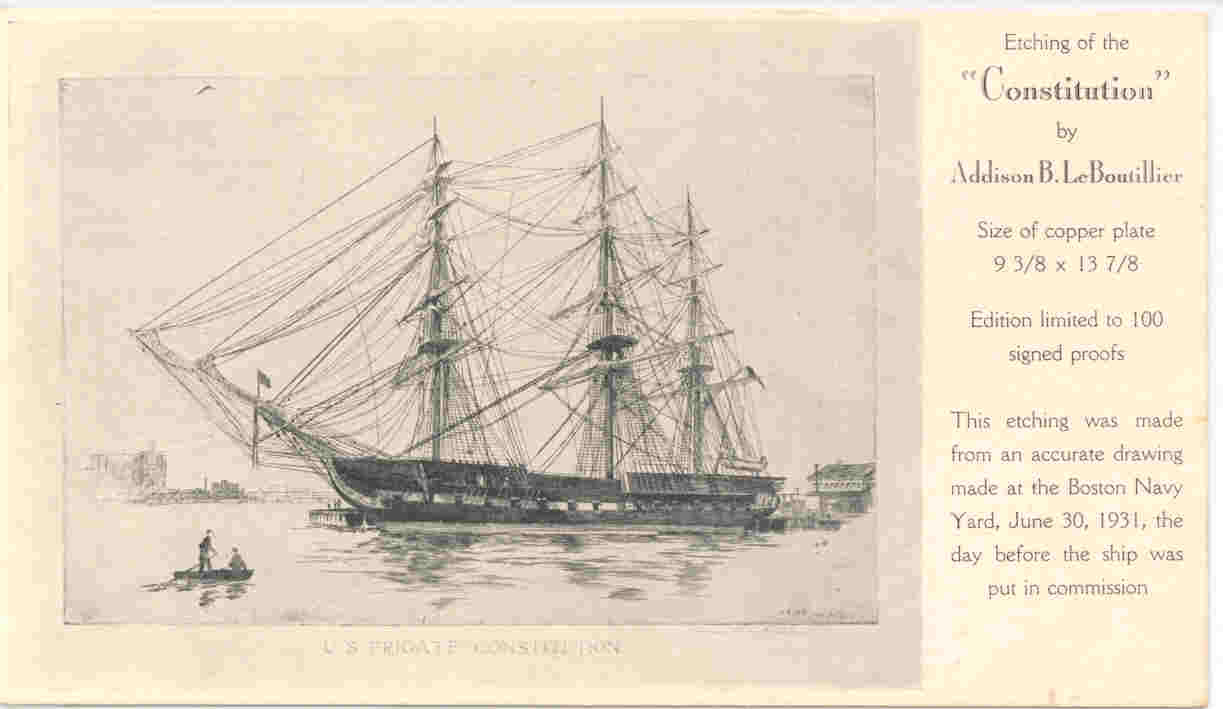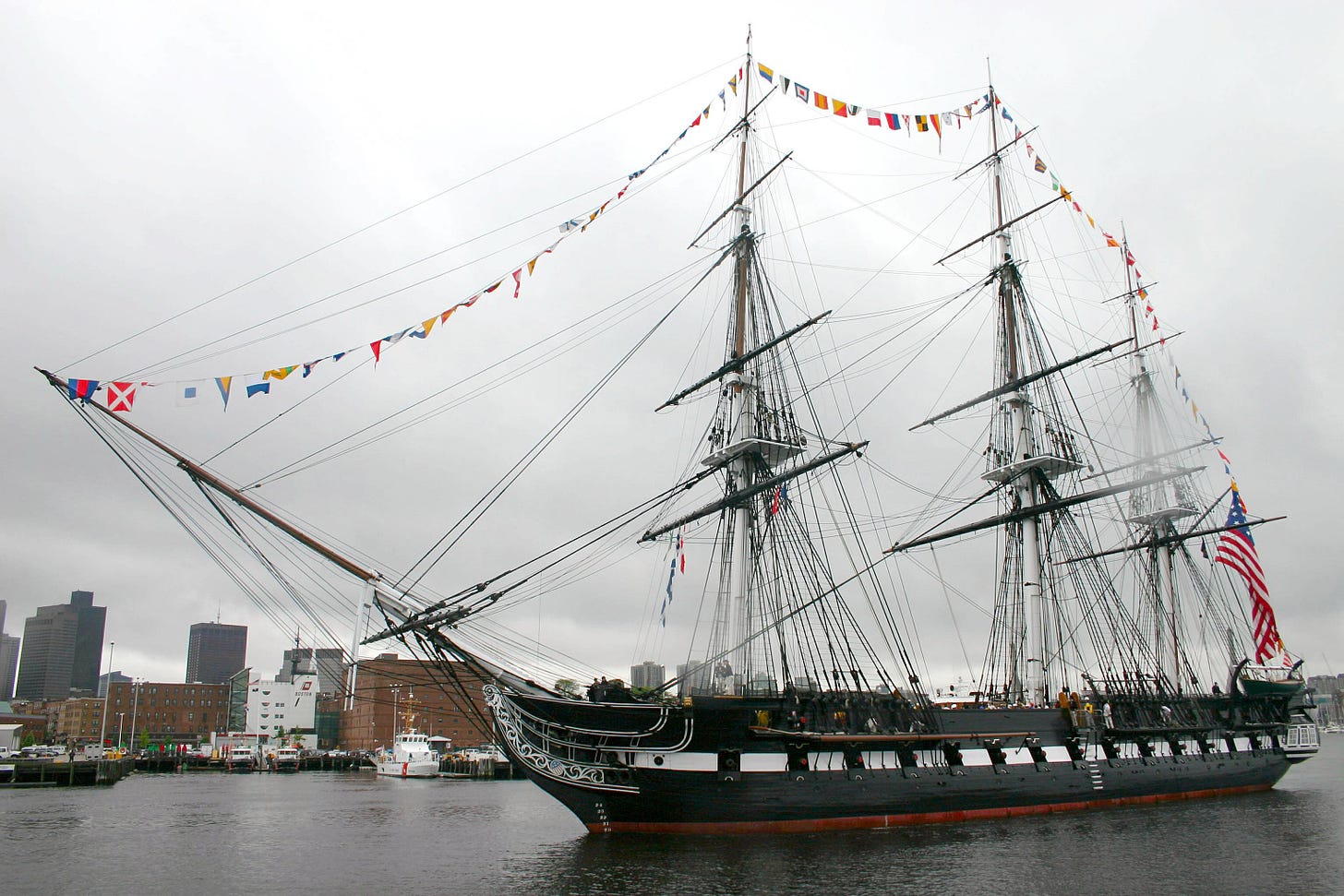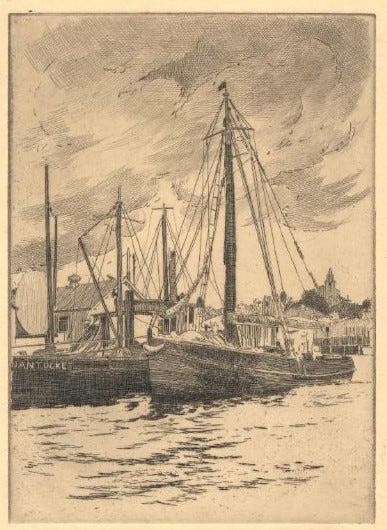Etching of the USS Constitution by Addison LeBoutillier
Exploring the history of a ship, an artist, and a type of printmaking, from looking at one image in the collection of the Andover Center for History and Culture.
Today we’re pleased to introduce new History Buzz writer Kathryn Stamps. In her monthly posts, Kathryn will be exploring the historical context of selected images from Andover Center for History and Culture and other historic collections. Welcome, Kathryn!
In the 1930s, the USS Constitution sailed home to retire in Boston Harbor. The Andover-based artist, designer, and architect Addison LeBoutillier created his own artistic rendering of the iconic warship in this delicate and skilled etching.

Old Ironsides Sails Home
The USS Constitution was one of six major warships built at the start of the U.S. Navy. As a new nation, the United States found its security and shipping trade at risk due to pirates and European power struggles at sea. In 1794 “An Act to provide a Naval Armament” was signed into law by President George Washington, authorizing the building of six massive frigate warships, one of which, was the USS Constitution.1 Frigates from that era were three-masted warships that acted as scouts or escorts to protect other ships, often in a convoy.2
During a battle in the War of 1812, the British ship HMS Guerriere's cannonballs were seen bouncing off Constitution's hull, which is the bottom part of the ship, instead of breaking through. This event led to the USS Constitution being nicknamed Old Ironsides. The secret to this defensive strength was in the construction. The hull had been designed with its vertical wood slats closer together than those of previous warships.3
In 1830, when the ship had seen much fighting and was considered ready to be disassembled, Oliver Wendell Holmes Sr., the prominent Boston physician and writer, wrote a poem that raised public awareness and helped to save the ship from the junk heap. Here are a few lines from his poem, "Old Ironsides":
No more shall feel the victor’s tread,
Or know the conquered knee;
— The harpies of the shore shall pluck
The eagle of the sea!4
In the 1930s, after having been repaired and sent back out to serve various functions for the Navy, the USS Constitution returned to Boston to become a museum that the public could visit and learn about. That is when Addison Le Boutillier, along with many other visitors would had the opportunity to spend time getting to know the old warship.
To this day, the USS Constitution still has an active crew. This year, 2022, it got its first female captain, Commanding Officer Billie J. Farrell. She is the ship's 77th commanding officer.5
Several turns of fate led this particular frigate to become an iconic symbol of U.S. Naval power. But as a lifelong close observer and artist, Addison Le Boutillier may have been also impressed by the architectural structure and time-tested craftsmanship, when he came to the harbor to sketch the old ship.
Drawn to the Sea
Addison Le Boutillier was born in Utica, New York in 1872. In childhood he enjoyed drawing, and as a teenager he thought about becoming an architect. He visited Europe twice in his lifetime, with his sketchbook at hand. After spending some time in Chicago he found his permanent artistic and professional home in New England, settling in Andover in 1905. In his long career, he worked in jewelry design, graphic design, architecture, and ceramic design. All the while, he honed his drawing skills. He made many charming sketches of the people and places he encountered.6
Le Boutillier was a part of the Arts & Crafts movement, which had an aesthetic that valued craftsmanship and attention detail. In 1926, his architecture partner Hubert G. Ripley wrote a glowing article about Le Boutillier's etchings in The Print Connoisseur, published in Champlain, New York. In the article Ripley observed that,
"in his etchings, LeBoutillier has shown first, a beautiful quality of line combined with faithful exactitude in draughtsmanship; second, a sympathetic feeling for material, and third, an unerring sense of composition. There is a naturalness and freedom from eccentricity, a restraint in the use of tone that is most refreshing."7
Two years after he made the etching of the USS Constitution, Le Boutillier retired from his work in architecture and moved from Andover to the artists' haven Rockport, Massachusetts, on the coast north of Boston.8
Etching
The printing technique with which LeBoutillier created the image of the USS Constitution is called etching, and it dates back to the 1500s in Southern Germany. It then became a popular medium in Italy before spreading to the rest of Europe. It can be an appealing type of printmaking to artists who like to draw and sketch instead of carve into surfaces as with woodblock printing.
An etching is started by preparing a copper plate with a layer of wax. The artist can then sketch with a sharp metal point directly onto the prepared copper plate. When the sketch is done, acid is used to transform the plate's sketch into a surface that can be inked and printed by rolling it on top of paper through a high pressure printing press. The result is a print that looks similar to a drawing. Several nearly identical prints can be made from the one plate, allowing the artist to make a edition, which is a series of prints.9
Take a look at this quick and fun demonstration of the process of creating an etching: https://www.metmuseum.org/about-the-met/collection-areas/drawings-and-prints/materials-and-techniques/printmaking/etching.
Have you visited the USS Constitution ship and museum? Are you inspired to carry a sketchbook with you the next time you go to visit a historic site? What craft or skill do you enjoy working on or learning about?
- Kathryn
Image Credits:
Artworks by Addison B. Le Boutillier, in the online collection of the Andover Center for History & Culture: https://andoverhistoryandculture.pastperfectonline.com/Search?search_criteria=Addison+LeBoutillier&onlyimages=false
Photograph of the USS Constitution by Journalist 1st Class Dave Kaylor, uploaded July 2006: https://upload.wikimedia.org/wikipedia/commons/e/e1/USS_Constitution_Departs.jpg
USS Constitution Museum website: https://ussconstitutionmuseum.org
Frigate Definition & Meaning - Merriam-Webster
Video by the USS Constitution Museum: www.youtube.com/watch?v=fXYz7-N6J88
Poem "Old Ironsides" by Oliver Wendell Holmes Sr., https://www.poetryfoundation.org/poems/46547/old-ironsides
USS Constitution crew members: https://www.navy.mil/USS-CONSTITUTION/Old-Ironsides-Crew/
Clark Pearce with research by Neville Thompson, “Addison B. Le Boutillier: Andover Artist and Craftsman” Andover Historical Society exhibition booklet, 1987.
Hubert G. Ripley, article "The Etchings of A. B. LeBoutillier" in "The Print Connoisseur," Winfred Porter Truesdell, Champlain, New York, January edition, 1926.
See reference 6.
A short history of etching on the Metropolitan Museum of Art website: https://www.metmuseum.org/toah/hd/etch/hd_etch.htm







Interesting story Kathryn. I love LeBoutillier - such a Renaissance Man. Beautiful etching...
Great first post, Kathryn...and welcome!
Tom Adams